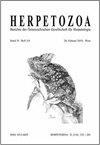A tale about vipers’ tails: phylogeography of black-tailed rattlesnakes
IF 0.9
4区 生物学
Q3 ZOOLOGY
引用次数: 0
Abstract
The phylogenetic relationships among black-tailed rattlesnakes remain poorly understood and some authors indicated that the diversity of this group has been underestimated and additional analyses are required to clarify the biogeographic patterns throughout its distribution in Mexico. Therefore, the aim of this study was to elucidate the phylogenetic relationships among black-tailed rattlesnakes across their range, identifying relative divergence times among the main clades and reconstructing the biogeographical history of the group. Three partial mitochondrial genes (ND4, cytb and ATPase6) and one nuclear gene (RAG1) were sequenced to infer the phylogenetic relationships, through the maximum likelihood and Bayesian inference-based methods; demographic history reconstruction was investigated through Bayesian Skyline plot analysis and the ancestral area reconstruction was carried out considering a Bayesian framework. We found strong evidence that the black-tailed rattlesnakes’ group is composed of six clades, which is in agreement with subspecies previously reported. Divergence time estimation indicated that the origin of the C. molossus group could be traced to the middle of the Miocene (~7.71 Mya). Ancestral area reconstruction indicated that early divergence events occurred in Central Mexico, probably related to the geological dynamics of the Trans-Mexican Volcanic Belt. The lineage C. m. oaxacus is the basal member of the C. molossus group. Furthermore, the combination of geological events and changes in Quaternary vegetation may have contributed to the divergence of C. molossus clades. Our results suggest several clades within C. molossus complex could be potentially recognized as separate species.A关于毒蛇尾巴的故事:黑尾响尾蛇的系统地理学
黑尾响尾蛇之间的系统发育关系仍然知之甚少,一些作者指出,这一群体的多样性被低估了,需要进一步的分析来阐明其在墨西哥分布的生物地理模式。因此,本研究的目的是阐明黑尾响尾蛇在其分布范围内的系统发育关系,确定主要分支的相对分化时间,重建该类群的生物地理历史。通过最大似然和贝叶斯推理方法,对3个线粒体部分基因(ND4、cytb和ATPase6)和1个核基因(RAG1)进行测序,推断其系统发育关系;通过贝叶斯Skyline地块分析进行人口历史重建,并考虑贝叶斯框架进行祖先区重建。我们发现了强有力的证据,表明黑尾响尾蛇的种群由六个分支组成,这与之前报道的亚种一致。分化时间估计表明,C. molossus类群的起源可追溯到中新世中期(~7.71 Mya)。祖先区域重建表明,早期的分岔事件发生在墨西哥中部,可能与跨墨西哥火山带的地质动力学有关。该谱系是molossus类群的基础成员。此外,第四纪植被的变化和地质事件的共同作用可能促成了molossus枝的分化。我们的结果表明,molossus复合体中的几个分支可能被认为是单独的物种。
本文章由计算机程序翻译,如有差异,请以英文原文为准。
求助全文
约1分钟内获得全文
求助全文

 求助内容:
求助内容: 应助结果提醒方式:
应助结果提醒方式:


